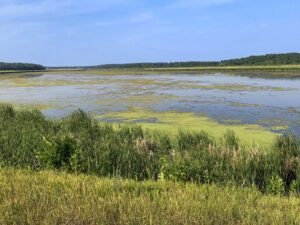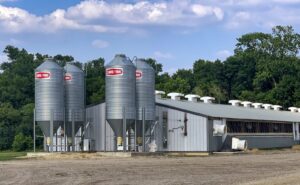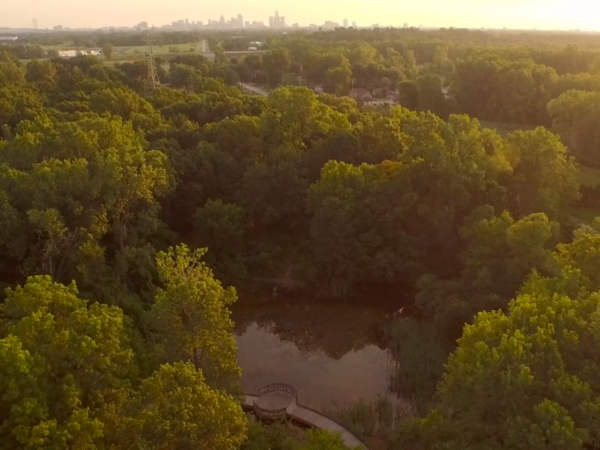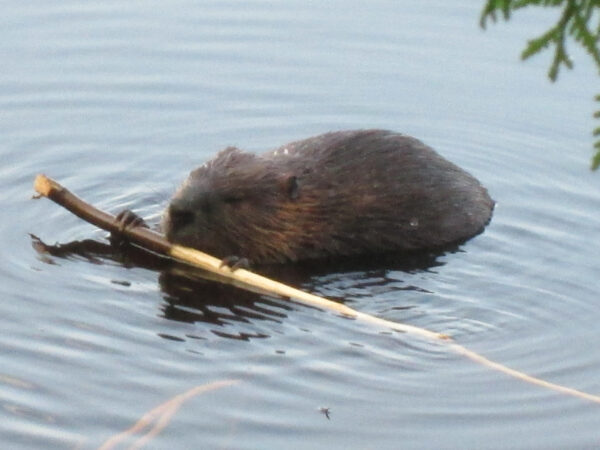
By Keith Schneider, Circle of Blue
The Great Lakes News Collaborative includes Bridge Michigan; Circle of Blue; Great Lakes Now at Detroit Public Television; and Michigan Radio, Michigan’s NPR News Leader; who work together to bring audiences news and information about the impact of climate change, pollution, and aging infrastructure on the Great Lakes and drinking water. This independent journalism is supported by the Charles Stewart Mott Foundation. Find all the work HERE.
MAHNOMEN, MN. – It’s been centuries since the White Earth Band migrated west across North America, following an ancestral prophecy to go where “food grows on water.” One of seven Ojibwe bands in Minnesota, White Earth found that prophecy fulfilled along the many shallow clear lakes that lie in the state’s northern forests, where luminous green stalks of wild rice grow in abundance.
The lakes and the magnificent bounty of wild rice still form the spiritual foundation of a culture, economy, and way of life for the tribe, which inhabits the White Earth Reservation that was created in 1867 through a treaty the United States signed with the Mississippi Band of Chippewa Indians.
“Everything that revolves around that rice revolves around all of us,” explained Michael Fairbanks, the tribe’s chairman.
That way of life is under threat, however, as industrial-sized dairies, hog facilities, and big crop farms are beginning to surround the tribe’s 829,440-acre reservation near the North Dakota border. The agricultural operations bring ruinous nutrient pollution that has been documented in all of Minnesota’s farming counties, and massive groundwater withdrawals for irrigation and livestock.
“When you look at the magnitude of these factory farms, the level of waste they produce, it’s horrible,” Fairbanks said.
In response, White Earth Nation is implementing a series of mandatory and enforceable pollution prevention and water conservation measures that challenge the orthodoxy of voluntary practices that states and the federal government have embraced for the last half century.

Algae chokes North Fork of Crow River northwest west of Minneapolis, a consequence of nutrient pollution from farm fields. (Photo by Keith Schneider / Circle of Blue)
Taking A Stand
Leveraging its treaty-granted sovereign nation status, the tribe is effectively establishing its own authority to issue permits for these farming expansions. The White Earth Band is one of a growing number of Native American tribes exerting their authority to protect reservation water reserves. In Michigan’s Upper Peninsula the Keweenaw Bay Indian Community, along the shores of Lake Superior, started two years ago to set surface water quality standards for lakes, rivers and streams in its jurisdiction.
On December 1, 2022, the White Earth Band set a two-year moratorium on the development of large livestock and dairy operations within its reservation boundary. The moratorium is designed to allow the tribe time to conduct thorough research and establish rules and a regulatory program to prevent “environmental hazards” from industrial livestock operations “in a manner that protects the Band’s core interests related to human health, natural resource protection and economic security.”
“Before the ordinance what recourse did we have for a farm operation that comes in here under a permit from a state agency, or whoever permitted them?” said Dustin Roy, the tribe’s director of natural resources.
“They can just pack up and go and leave us picking up the pieces of what’s ever left. That’s what we’re concerned about. I’m worried about the stream corridors, the rice, the fisheries we have. If it gets polluted that’s going to harm a lot of people,” he said.
In May, the tribe enacted a second ordinance to establish its own review and permitting process for allowing or denying new high-capacity water wells capable of pumping more than 10,000 gallons per day or 1 million gallons per year. The tribal well standards are intended to supplant a state well permitting program administered by the Minnesota Department of Natural Resources (MDNR).
Tribal authorities said the MDNR permitting process was not sufficiently rigorous to protect reservation groundwater from depletion or pollution from increasing numbers of high capacity wells approved by the state.
“We have all kinds of permitting issues with the state,” Roy said. “They allow high capacity wells without our consultation or say. It’s just grown and grown and grown, which triggered the need to draft ordinances to protect our waters from being drained.”
MDNR administrators did not respond to a request for interviews.

Cliff Krowell (l), who manages water and rice, and Will Bement, the tribe’s fisheries manager, at the site of Riverview’s proposed 20,000-cow dairy. The tribe convinced the company not to build the dairy. (Photo by Keith Schneider / Circle of Blue)
New frontline
In adopting regulations to regulate water consumption and improve nutrient management in industrial livestock and crop production, the White Earth Band has built a new frontline in the intensifying skirmish to hold mainstream agriculture accountable for its polluting and water-wasting practices.
The tribal rules are a clear rebuke to farm states and the federal government, which have advocated voluntary participation in pollution prevention and water conservation programs that have cost taxpayers billions of dollars. Even with direct support and low interest loans to pay for them, federal and state figures show most farmers don’t participate. And federal and state water monitoring data show that farm nutrient pollution is getting worse.
Roy asserts there is ample justification for the new regulatory program. Big farm operations have their eyes on the flat and forested lands of northern Minnesota, which are not nearly as developed for livestock and crop agriculture as the rest of the state. A 10,000-cow dairy, developed by Minnesota-based Riverview, opened near the reservation’s western boundary a year ago. A big hog operation, approved in May, aims to spread its manure on reservation-controlled land. Large, irrigated crop farms also are under development around the reservation.
The Minnesota Department of Natural Resources is also considering issuing several large irrigation permits for crop farms within and immediately adjacent to the reservation boundaries.
Working amid stacked boxes of research reports and legal documents inside a one-story office building here, Roy and his natural resource colleagues are overseeing the development of regulations and a permitting program that sets mandatory standards of environmental performance for farm operations.
Jamie Konopacky, the White Earth Nation attorney who wrote the ordinances, said five notices of potential violation have been issued so far, three of them to the owners of the Becker County hog operation to block spreading manure on tribal lands.
“The band does, as a sovereign nation, have the authority to protects its natural resources and its people on the reservation,” she said.

Large swine operations are ubiquitous in Minnesota, the nation’s second largest hog production state. (Photo by Keith Schneider / Circle of Blue)
River of Farm Waste
By no means has Minnesota ignored the tide of farm nutrients contaminating its waters. State authorities working with legislators and governors have responded over the last 30 years much like other farm states and the federal government – by building an unsteady foundation of policy and programs supported by considerable investments in science and administration.
Minnesota monitors its surface and groundwater for nitrate contamination. It tracks the development of wells that draw large amounts of water. It developed a formal nutrient reduction strategy and a separate fertilizer management plan. University of Minnesota researchers publish peer-reviewed papers that identify sources of contamination and their consequences for drinking water and the environment. State leaders convene regularly in conferences with regulators, scientists, local officials, and community groups that focus on nutrient pollution.
The investment in science and administration should set the state up for effective action. So should the more than $5 billion the US Department of Agriculture provides farmers in Minnesota and every other state for conserving resources and water. They include voluntary “best management practices” to impede nutrient runoff such as planting cover crops, cultivating buffer strips along ditches and streams, not plowing fields, and replacing cropland with meadows and pasture.
Such practices were principally designed to slow soil erosion. They haven’t displayed much effectiveness in keeping nutrients out of water. And despite the taxpayer support most farmers don’t use them. The consequence is that halting contamination at the water’s edge, or into groundwater in Minnesota, has been elusive, to put it mildly.
Just as in the other 10 Corn Belt states, Minnesota’s 25.4 million acres of farm land is deluged with fertilizer and ever more nitrogen-rich manure. Each year nearly 800,000 tons — 1.6 billion pounds — of commercial nitrogen fertilizer are applied on the state’s row crops, principally to grow 8 million acres of corn, according to state and federal figures.
Livestock producers, who raise cows, cattle hogs, and poultry by the thousands in immense feedlots generate 49 million tons of nitrogen-rich manure. Minnesota’s hog population, now the second largest behind Iowa, numbers 8.9 million animals, more than double the 3.6 million pigs raised in the state 50 years ago..
There are no limits to the volume of nutrients crop farmer can apply, and scant regulation on spreading manure on farmland. Millions of pounds of nitrogen not absorbed by growing plants runs off fields into streams and lakes, or drains into groundwater. Across Minnesota, monitoring by state agencies has confirmed widespread contamination. From 2013 to 2019 the Minnesota Department of Agriculture tested more than 32,000 wells in 344 townships and found 9 percent contained nitrate levels over the safety standard.
In a 2013 report the state Pollution Control Agency found excess concentrations of nitrate in 297 of the 728 streams – 41 percent – that it measured across Minnesota. The agency also reported that 158 million pounds of nitrogen drains from state farmland annually into the Mississippi River and is a primary cause of the huge dead zone where the river empties into the Gulf of Mexico. The Pollution Control Agency promised to develop an enforceable limit for nitrates in Minnesota surface waters. But that program was never completed.

The result of excess farm nutrients running off farm fields and from large swine production facilities. (Photo by Keith Schneider / Circle of Blue)
Best Management Practices Don’t Work
Since 2010 the state has spent an average of $103 million annually to prevent water pollution from its sales-tax funded Clean Water, Land, and Legacy Fund. The fund modernized water treatment plants and preserved 17,000 acres along streams and rivers as unplanted natural areas.
The fund also provided low interest loans to 1,100 of the state’s 67,400 farms to deploy those voluntary best management practices. They didn’t work.
The results for nutrient contamination, according to the most recent state assessment, are dismal:
- “Nitrates are increasing in major rivers.”
- “Since 1992, there has been a general increase in the percent of new wells that have nitrate levels above the drinking water standard.”
- “Township testing data show a high level of nitrate in some vulnerable aquifers in the Central Sands” region of the state.
- “Township testing data show a high level of nitrate in some vulnerable areas in southeast Minnesota.”
The White Earth Band is intent on avoiding the nutrient mess. Its resolve clearly influenced Riverview’s decision earlier this year to withdraw a plan to build a 21,000-cow dairy close to the 10,000-cow operation that opened in June 2022.
During a meeting with Roy, Konopacky, and Cliff Krowell, who manages the tribe’s water and rice production, Riverview executives said the new dairy would use 80 million gallons of groundwater annually. Riverview, which did not respond to requests for an interview, also said it would need 300 million gallons for the dairy drawn from the Wild Rice River, which supplies Lower Rice Lake, the tribe’s principal source of wild rice.
The Riverview team decided to take their project elsewhere, according to Roy, after they learned the tribe operates a small dam that controls the river flow. The tribe uses the dam to make sure there is enough water in the lake to grow rice and to float boats for harvest.
“We mentioned that to them,” said Roy. “It was like someone popped them right in the nose. They had no idea that we have the ability to manage water upstream on the river. There was dead silence for two weeks. Then Riverview sent an email and said “we’ll go elsewhere.”
More ordinances are planned. “Any government, any sovereign entity, has the right to respond to ongoing challenges to the community,” added Konopacky. “The [tribe] is no different than other governments in terms of taking the action that’s necessary to protect people and the environment. And given how sacred these issues are to their cultural sustainability, when compared to other governments they take regulatory actions more seriously.”
This article, the latest in the Toxic Terrain series about farm nutrient pollution, is co-published with The New Lede.
Catch more news at Great Lakes Now:
Workers needed to fulfill America’s infrastructure goals
Featured Image: Wild rice in 2,000-acre Lower Rice Lake, the tribe’s principal source of a harvest that commences in the fall. (Photo by Keith Schneider / Circle of Blue)




